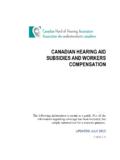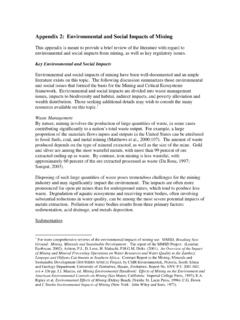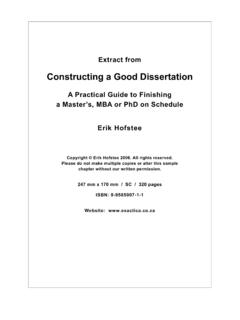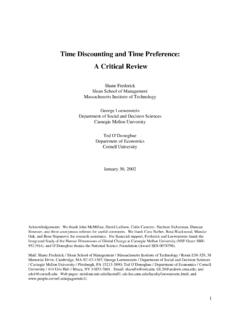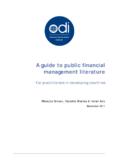Transcription of The Impact of Speechreading Programs on Adults with ...
1 The Impact of Speechreading Programs on Adults with Hearing Loss literature review Alena Wickware Project Manager National Speechreading Program The Canadian Hard of Hearing Association Completed: V1: February 27, 2014. V2: March 7, 2014. V3: April 8, 2014. This project is funded by the Government of Canada. The Impact of Speechreading Programs on Adults with Hearing Loss: literature review Table of Contents: Introduction 2-3. Background Information 3-5. Theory 5-11. Summary 11-13. Conclusion 14-16. Glossary 17-18. References 19-21. National Speechreading Project CHHA-AMEC 1. The Impact of Speechreading Programs on Adults with Hearing Loss: literature review Introduction This review was developed to provide the foundation of evidence-based practice currently available with regards to the efficacy of Speechreading techniques in improving communication, social interaction and overall quality of life in Adults with hearing loss.
2 This review of research will inform the National Guidelines developed to structure the Canadian Hard of Hearing Association's National Speechreading Program (NSRP), and offer credible resources that provide validity to the methods and approaches included in NSRP. Speechreading is here defined in general terms, as a method of oral communication in which one uses communication strategies to aid in dialogue when some of the auditory information is missing due to hearing loss or a noisy environment. This method makes use of the visual clues of the speaker's lip and facial movements, gestures, posture and body language, along with residual hearing to make use of the speaker's verbal communication, intonation and context to infer meaning (formerly known as lip reading). Other skills that are associated with Speechreading include behaviors and coping mechanisms that reduce the deficits in communication and function posed by hearing loss, including social activity, interaction, participation, and overall quality of life through a multifaceted approach of sensory management, instruction, perceptual training and communication repair strategies.
3 These coping skills can include communication and repair strategies to aid understanding. Speechreading is also used by people who have typical hearing, especially in situations that are noisy or the speech is unclear. Woodhouse et al (2009) published a review indicating five pieces of evidence that shows speech-reading is an integral part of speech processing. Hearing people's perception of speech is influenced by speech-read cues, and those speech-read cues cannot be ignored.. National Speechreading Project CHHA-AMEC 2. The Impact of Speechreading Programs on Adults with Hearing Loss: literature review The need for such a review of literature is borne out of the various research projects and academic reviews that exist, however; conflicting evidence and findings reveal a need for a comparison of viable skills and useful data that should be included in a comprehensive Speechreading program.
4 Additionally, there are a number of organizations and individuals that offer Speechreading instruction individuals with hearing loss across Canada, and this number is growing every year as the need for such courses is increasing. People with hearing loss are requesting tools to cope with this problem, but the level of quality, the content and the tools that are available vary considerably from one service provider to the other. There is no regulation of informal Speechreading courses, and currently there is no National Guideline in place to ensure the quality of these services. This review endeavors to provide a general overview of some of the research that has taken place over the past 35 years regarding the effects of Speechreading and aural rehabilitation on overall communication and quality of life in persons living with hearing loss (particularly Adults ).
5 Background Information For some of the literature reviewed, there are different terms used to describe the set of skills included in Speechreading . The terms lipreading and aural rehabilitation tend to be terms that encompass training of the similar skill sets, and regardless of the terminology used in the literature reviewed, for the purposes of this paper, the term Speechreading will be used throughout for clarity. The term Speechreading is preferred over lipreading, as Speechreading encompasses more skills than reading lips alone. National Speechreading Project CHHA-AMEC 3. The Impact of Speechreading Programs on Adults with Hearing Loss: literature review The use of Speechreading as a skill to aid in communication is not unusual and has been relied upon by people living with hearing loss for centuries.
6 The earliest recorded reference to Speechreading instruction refers to the Spanish Benedictine Monk, Pictro Ponce who was considered to be the first successful Speechreading teacher for pupils with hearing loss (Hassanat, 2009). In 1787, Samuel Heinecke opened the first Speechreading school for students with hearing loss in Leipzin, Germany. Speechreading was in practice in North America since the turn of the 19th century, with the inception of the first schools of the Deaf during the colonial period. Early Oral Programs often put emphasis on Speechreading skills as the primary method for learning a spoken language, before the acceptance of manual forms of communication in education for students with hearing loss (Crouch & Greenwald, 2007). Speechreading became an interest in the field of Audiology for its rehabilitative potential in the 1940s, as a response to the rising need for such services from veterans returning from World War II.
7 However, as noted by McCarthy and Schau (2008) the emphasis on rehabilitation in the profession of Audiology diminished over the ensuing decades, returning to focus on diagnostic procedures and the dispensation of Hearing Aids and other assistive devices. Erber (1988) observed that three tools were available during the 1940s and 50s, when servicemen and women were returning from WWII with significant hearing losses, including Hearing aids, Auditory Training and lipreading instruction . However, the turn in focus from Speechreading instruction to assistive technology is due in part by a loss in confidence in auditory training and Speechreading , and improvements to technology to augment the use of residual hearing. Arnold (1997) argues, Speechreading is still of value since it does not rely on technology, is a natural skill, and can also optimize the effectiveness of Hearing Aids and Cochlear Implants (Pp.)
8 199). Currently, Speechreading is becoming more popular among consumer groups and non-profit organizations as a complimentary method of understanding spoken communication, for National Speechreading Project CHHA-AMEC 4. The Impact of Speechreading Programs on Adults with Hearing Loss: literature review persons living with hearing loss. The reason for this preference is because once a person has learned Speechreading skills, it is cost-effective, can benefit people living with hearing loss at any age and any stage; it is a tool that can be implemented as needed and is flexible enough to be applied to meet a variety of needs, in a variety of situations. The following section discusses the Theories and Approaches that developed during the 20th century to structure how Speechreading as a skill was taught to people with hearing loss.
9 Theory There are four general approaches used to impart Speechreading skills: Analytic, Synthetic, Pragmatic and Holistic (Tye-Murray, 1998). Each approach had different models associated with them, and examples of each will be detailed. The Analytic approach was considered a traditional method of instruction for teaching Speechreading skills, and is generally defined as an approach that focused on the smallest units of speech to understand spoken communication. Hallmarks of this approach are rapid syllable drills emphasizing the practice of building smaller verbal units (the syllable or viseme) into words and then sentences (Hanavan, 2013). Analytic approaches include instruction that concentrates on the details of the sounds - learning to recognize how they look on the lips and practicing their recognition in isolation and in single words , the Mueller-Walle, Bruhn and Jena methods (Bruhn.)
10 1949; Bunger, 1952). The underlying theory is that the speechreader, deprived of some of the acoustic information, must work to interpret as much information as possible from the visible movements. An underlying assumption is that speech National Speechreading Project CHHA-AMEC 5. The Impact of Speechreading Programs on Adults with Hearing Loss: literature review perception is, basically, a bottom-up process in which the first task is to analyze the incoming visual signal into its basic components before assembling those components into words and sentences (Kaplan, et al. 1985). Some of the practices include syllable discrimination exercises, where the speechreader would be presented with two syllables ( , GA-BA or BA-BA ) and would then determine whether the two syllables were the same or different.
